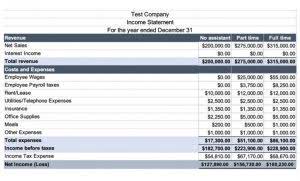
If you’re not already doing so, start requiring customers to pay upfront for goods or services. A great example of net cash flow is when a business has $20,000 in sales income and then pays out $15,000 in expenses. That’s the difference between what they took in and what they paid out – it’s their bottom line number that gives them a good snapshot of how much money they have on hand. To better read and understand your cash flow and cash flow statements, there are a few key terms to know. Liabilities normally represent a future surrender of resources; deferred inflows cash inflow vs outflow do not. Deferred inflows do not represent an obligation; they are simply revenues to be recognized in a future period (that is, they increase net position in a future period).
- While Excel is an improvement on manual tracking, computerized solutions like Quickbooks Online are also recommended.
- Specific studies show that foreign direct investment (FDI) is suitable for employment in emerging nations, but foreign portfolio investment is unfavorable for domestic employment generation.
- Business cash flow is important to understand because important people such as investors and bank lenders use it to analyze the financial health of your business.
- Financial reports and financial statements are often thought to be the same but they aren’t.
- Cash flow is the heartbeat of any company—whether you’re a startup or an established enterprise, staying in control of your finances is key to long-term security.
- A leveraged buyout (LBO) is a transaction in which a company or business is acquired using a significant amount of borrowed money (leverage) to meet the cost of acquisition.
India’s choice for business brilliance

It is essential to keep the business running by paying employees, suppliers, and other expenses. Without adequate cash flow, a business can run into financial trouble and potentially go bankrupt. Fund flows refer to the movement of money into or out of investment funds, such as mutual funds, exchange-traded funds (ETFs), or index trial balance funds.

Using Brixx for cash flow forecasting

Negative cash flow, in contrast, means that you’re spending more money than you’re taking in. What you really want is deep insight into the breakdown of cash inflows and outflows so you can continuously improve efficiency and map out more strategic growth plans. This usually refers to the income a business produces through sales, as well as financing and even investment activities. Keep in mind, however, that something like a loan is technically a cash inflow, even though it will result in future cash outflows as you repay your debt. Effective management of cash inflow and outflow is foundational to a company’s financial strategy, offering a clear view of its operational performance and future viability.
- This would mean that the restaurant has additional disposable income—positive cash flow of $15,000 every month—which can be put towards further investments or saved for slow times.
- Under the new leadership, Twitter has taken substantial steps to control its costs.
- Understanding the differences between cash inflow and cash outflow, and how to manage both effectively, is critical for managing your business finances with confidence.
- Reliable cash inflow ensures that the business has adequate cash on hand to cover its daily operational expenses.
Cash Inflow vs. Outflow: What’s the Difference?
- The services and products offered on the website are subject to applicable laws and regulations, as well as relevant service terms and policies.
- A robust cash inflow is indispensable for keeping your business buoyant, facilitating reinvestment, and covering the spectrum of operating expenses.
- You need to immediately establish a budget you can live with and then begin following it as closely as possible.
- Consider different scenarios that could affect your cash flow, such as changes in market conditions or unexpected expenses.
- Outflow from operating activities directly relates to the company’s buying and selling.
- The net cash position after capital expenditure, purchases or sales of investments, open market securities, and mergers & acquisitions is cash flow from investing activities.
Inflows and outflows are related because they’re both essential components of your company’s operation. But they must be kept in balance and appropriately monitored to ensure your company’s long-term viability. Overall, proper cash flow management is a cornerstone of business success, providing the stability needed Debt to Asset Ratio to expand and flourish in a competitive market. Risk Disclosure This presentation is for informational and educational use only and is not a recommendation or endorsement of any particular investment or investment strategy. Investment information provided in this content is general in nature, strictly for illustrative purposes, and may not be appropriate for all investors. It is provided without respect to individual investors’ financial sophistication, financial situation, investment objectives, investing time horizon, or risk tolerance.
- Finally, consider future cash inflows from existing projects as well as future investments when evaluating both the cash flow statement and its corresponding balance sheet.
- Proceeds from sales, positive investments, and profitable financial activities all play a part in growing your cash inflow.
- Cash flow statements must be monitored regularly by businesses to ensure the cash flow is positive.
- It reflects the demand for a company’s products or services and is an essential indicator of business success.
- Cash flow is the broad term representing the full amount of both income and expenses of your business; so it does not necessarily determine your profit.

These examples underscore the various avenues through which a business’s funds are utilized to maintain, operate, and grow the entity. Each of these processes highlights how businesses can generate cash, ensuring they have the necessary funds to thrive and expand. In addition to flows to and from groundwater, flow on river reaches can be reduced by Evaporation and Flooding, and increased by Surface Water Inflow.
